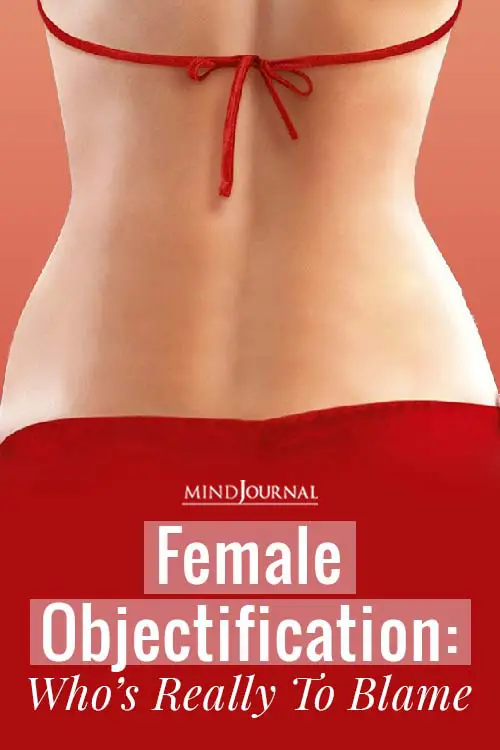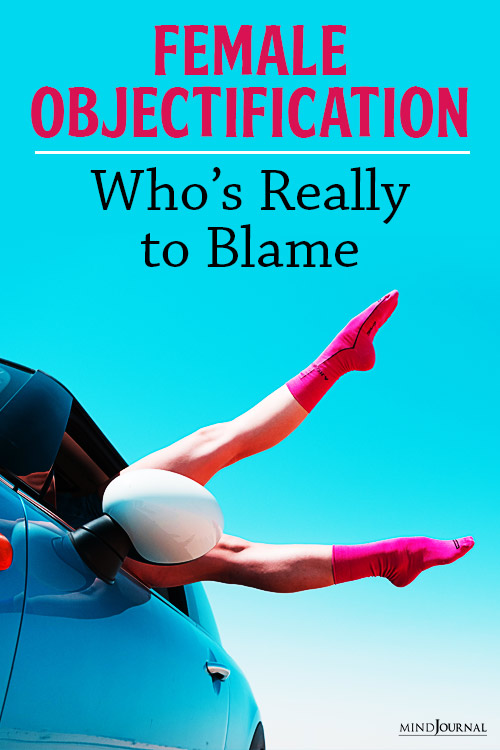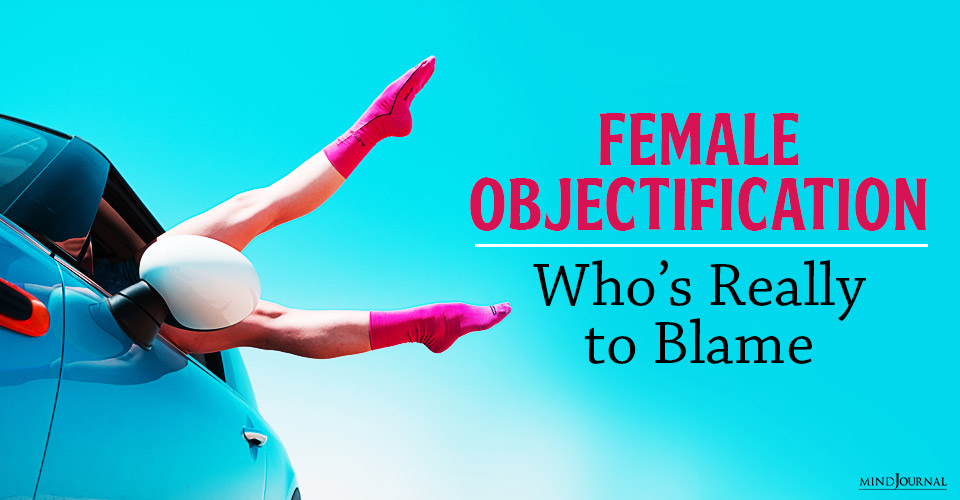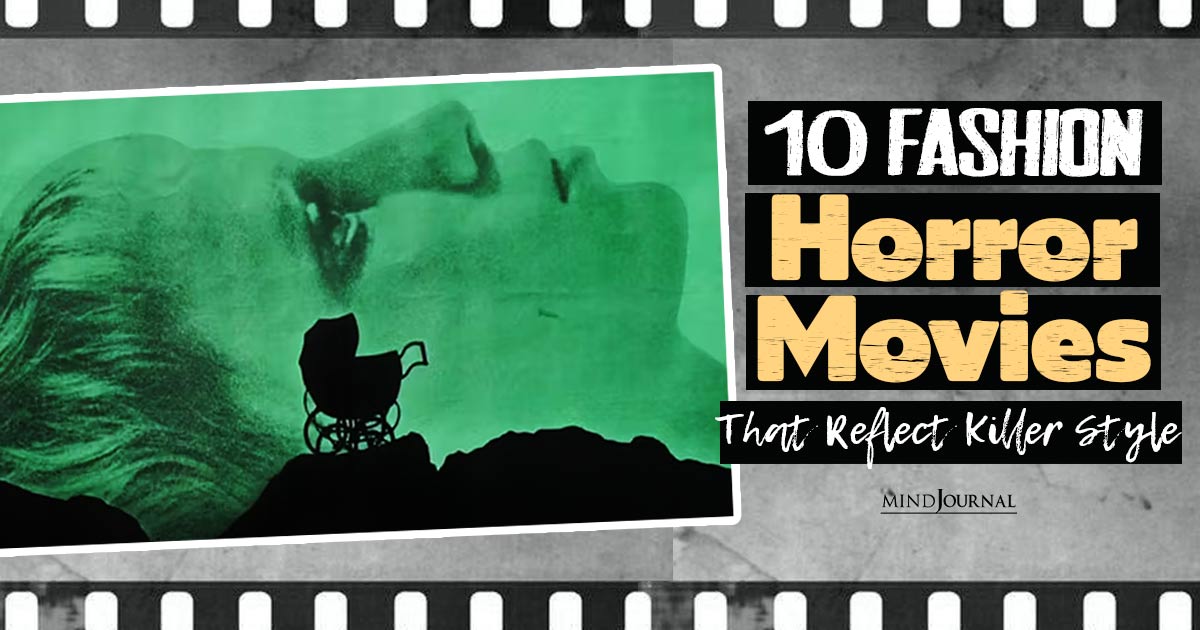Written by: Lexie Kite, Ph.D., and Lindsay Kite, Ph.D. authors of the book More Than a Body.
Women are constantly being dehumanized and reduced to objects to be groped, harassed, catcalled, and evaluated — and some men feel comfortable doing female objectification and then boasting about it, or deny it by mocking the appearance of the women as unworthy of their assaults.
In a culture that routinely portrays and values women as objects, who is really to blame when real-life women are reduced to objects? How do we stop female objectification?
Let’s get this out of the way upfront: objectification is not the same thing as admiring someone’s appearance. We all instinctively notice and evaluate appearance on some level, and it is perfectly natural and good. No shame necessary. Since objectification starts as a mental process, the only person who can determine if they’re objectifying someone is the person doing the potential objectifying.
However, there are some signs that you’re perceiving someone as an object rather than a full-fledged human being. Ask yourself some questions:
- Am I viewing that person primarily as a tool for my sexual gratification?
- Am I catcalling or harassing people with comments about their appearance or sex appeal?
- Am I talking about these people primarily in terms of their appearance or sex appeal?
- Am I considering these people as my equals and as active agents of their own lives, or am I considering them as passive objects or ornaments for my evaluation/consumption/use?
Obviously, “yes” answers = likely objectification happening. This is effectively viewing someone as less than human. This is bad. Let’s fix it.
Lots of people would have you believe that women, and their appearance or clothing choices, are the ones at fault for being objectified.
After all, if your clothes are tighter or shorter or flashier or anything-er than someone else thinks is acceptable, then you intended for others to think of you as more of an object than a person, right? So wrong. Dang, it would be SO easy if objectification worked this way! If this was true, then we could stop female objectification in its tracks by simply dressing more appropriately (as has been suggested by many a viral blog post).
But, alas, there are 3 fatal flaws with this philosophy:
1. Distinct victim-blaming mentality
It embraces a distinct victim-blaming mentality that puts the responsibility for how one is perceived on the shoulders of the one being perceived, rather than the one doing the perceiving.
Here’s a hard truth for some: Regardless of what you wear or how you look, you can never sufficiently defend yourself from objectification. Leggings or no leggings, you don’t get to decide whether people perceive you as a sex object or a person. You could wear the most appropriate outfit you could fathom and someone could still see that flash of wrist or ankle or outline of your body and blame you for sparking sexual thoughts.
If we are teaching the girls in our lives that the primary objective of appropriate clothing is to keep themselves covered so boys and men don’t think sexual thoughts about them, then we are teaching girls they are responsible for other peoples’ thoughts. That’s a burden no one should feel like they need to bear. Keep reading for our ideas on how you could teach girls and women (and boys and men) to consider their own clothing choices.
Related: A Guide To Understanding The Fear Of Abandonment And Object Constancy
2. Everyone’s definition of “appropriate” is different.
Everyones. One person’s sophisticated sleeveless blouse is another person’s lingerie. One person’s comfy, inexpensive, covered-up leggings are another person’s too-hot-for-TV sexy pants. (Obviously, we’re referring to definitions of appropriate that can vary significantly but still fall within legal, common public attire and that fit dress codes for certain venues.)
And the context! Oh, the context. If objectification is really determined by what a woman is wearing, then the context in which she’s wearing those clothes is totally irrelevant.
You can’t say, “She shouldn’t wear leggings on the street if she doesn’t want to be objectified,” and also flip-flop to believe she doesn’t deserve to be viewed as an object if she’s wearing those leggings at the gym or training for a marathon.
You also can’t say, “She shouldn’t wear that short skirt at dinner if she doesn’t want to be objectified,” and simultaneously believe she’s not at fault for being objectified while wearing the same skirt playing tennis or using it to cover up a swimsuit at the pool.
If “inappropriate” clothing choices directly result in female objectification, then there can be no on/off switch for the context of those clothing choices. They cause women to be viewed as objects or they don’t.
Related: 8 Tricks Narcissists Play To Manipulate Their Victims
3. The evidence of objectification is not determined
The evidence of objectification in action (catcalling, sexual abuse, and assault, etc.) is not determined or dissuaded by the clothing the objectified person (victim) is wearing.
Girls and women across the world are raped and assaulted and hollered while wearing flannel pajamas and cold-weather running gear and clubbing dresses and everything in between. Even in cultures where women are required to or choose to cover up a great deal, there is still an incredibly high incidence of rape and sexual violence.
And in some cultures where clothing is optional (ex: some African tribes), rape and sexual violence are reportedly very low. I am very regularly catcalled (in explicit, anger-inducing ways) while wearing a winter coat and jeans or a skirt below the knee while walking in downtown Salt Lake City. Why? Not because of my sexy clothes, I can assure you.
See this link for a bunch of examples to dispel the myth that scantily-clad women are more likely to be catcalled or assaulted. Harassment, sexual abuse, and assault are often about power, and men assert their power over women by publicly degrading them and/or abusing them as sexual objects for their own gratification.
In summary: You could never be clothed perfectly enough to ensure everyone perceives you the way you intend to be perceived. You could never obscure your shape or essence or beauty enough to prevent someone from having sexual thoughts about you and blaming you for those thoughts.
That is because objectification happens in the eye and minds of the beholder. You are the only one who can control whether you objectify another person. Yes, it can be triggered by images and messages we have learned to view as sexual and suggestive. No, that doesn’t mean it is unavoidable. And NO, that does not mean you can blame anyone else when you view her/him as an object.
We must take responsibility for ourselves – our own thoughts, our own intentions, and our own actions. [Please note: we are referring to face-to-face or person-to-person judgments and perceptions, not perceptions of media. Obviously, the media purposefully and blatantly presents women as objects. We’re not letting them off the hook for that. We need to cut objectifying media out of our visual diets and re-train our minds to see people instead of objects in both media and face to face. More on that in a second.]
By and large, it is girls and women who are being sexually objectified.* Many women even voluntarily sign up to be portrayed as objects and accept huge paychecks in return (think any men’s magazine, commercials for hundreds of otherwise non-sexual products, etc.). Being valued as an object is glamorized and sold as the highest form of power a woman can wield.
Of course, that is a lie, and that faux “power” is at the mercy of others’ (usually men’s) preferences, appetites and money.
The dangerous and normalized act of female objectification teaches men and boys that females are sexual objects above all else — that women exist to be looked at, consumed, and discarded.
No wonder the dehumanization and devaluation of women are often so invisible to men. It’s normal. It’s comfortable. It sucks that we might have to battle this devaluation our entire lives while also having to convince men (and other women) that female objectification not only exists, but that it is incredibly dangerous, and it needs to be fought against — not just by us gals, but by all of us.
We all learned how to view people as objects from the same sources — our shared media landscape. We live in a world where female objectification is so standard that it is invisible and unquestioned. But the only way to fight it is to see it and question it.
Sexualized female bodies are inescapable in media. Consider 90% of movies that have come out in the last decade and how they pan up and down women’s bodies and zoom in on their parts; Victoria’s Secret’s inescapable advertising in mailboxes, storefront windows, and TV; the good ol’ SI Swimsuit Issue celebrated on TV news programs and late shows, as well as public displays all across the country; Carl’s Jr.’s insanely sexist commercials, the list goes on and on and on.
Related: Attraction or Objectification? 5 Early Warning Signs To Know
Last but not least, one of the most profitable industries in the world is the absolute biggest perpetrator of female objectification: the porn industry. Hopefully, this doesn’t come as much of a surprise, but if it does, please know that it isn’t sexual shame, prudishness, or religious beliefs that tell us pornography is the guiltiest culprit in this fight against objectification.
While the porn industry has infiltrated all aspects of pop culture in the last couple of decades – leading us to barely flinch at images and acts on primetime TV that we would have been totally shocked by before, we have learned to view female sexuality as something to be viewed, purchased, and even stolen.
Female bodies have become objects to be bought and sold, both literally and figuratively, and with that commodification, girls and women have become devalued and dehumanized. In other words, objectified.
Female objectification not only affects the way men view women and the way we as women view and evaluate each other – but it also deeply affects the way we view ourselves.
This sexually objectifying culture persuades women to self-objectify by evaluating and controlling themselves in terms of their sexual appeal to others, rather than in terms of their own health, happiness, and desires. They literally picture themselves being looked at while they move throughout life. And what do you know? Girls and women suffer in very literal ways when sexualized female bodies inundate our media landscape.
Adolescent girls with a self-objectified outsider’s view of their bodies have diminished sexual health, measured by decreased condom use and diminished sexual assertiveness (the ability to say “no”), and decreased cognitive and physical abilities, including math, logical reasoning, and athletic performance.*
Add to that the fact that industries beg women to surgically implant things in their breasts and buttocks and lips to enhance their sexual appeal, and every year hundreds of thousands of women go under the knife, with 92% of those procedures – mostly breast augmentation and liposuction – performed on girls and women.
Self-objectification works as a harmful tool to keep girls and women “in their place” as objects of sexual appeal and beauty, which seriously limits their ability to think freely and understand their value in a world so in need of their unique contributions and insight
Though you cannot protect yourself from being objectified by others, please know that you CAN protect yourself from self-objectification.
You are more than your body and you’re capable of more than looking hot for others’ approval. You get the opportunity to reflect that truth every day in the way you carry yourself, what you do and what you say. We’ve written and talked extensively about this topic here and here, but today we’re going to highlight one aspect we addressed previously in this post, but in a totally different light: how we choose to dress.
Studies on self-objectification show us that “clothing represents an important contributor to the body and emotional experience of contemporary young women” because body-baring clothing leads to greater states of self-objectification, body shame, body dissatisfaction, and negative mood**.
What this tells us (and what our own experience living in female bodies tells us is a no-brainer) is that when we wear clothing that feels revealing or that overtly emphasizes our parts, we become very self-aware of those parts that are being (or could potentially be) looked at.
We self-objectify and are in a near-constant state of adjusting our clothing, thinking about what we look like, and looking at other people looking at us. It’s OK to like being looked at and even to like attention from others for our looks, but if it’s getting in the way of progress, happiness, and health — as so much research confirms that it is — we’ve got to make some changes.
Research shows a level of “modesty” or less-revealing/more-covered clothing can be an important tool in safeguarding ourselves from being in a constant state of self-objectification. This idea of “modesty” and less-revealing/more-covered clothing will inevitably vary from person to person and culture to culture — maybe even dramatically. That does not matter.
We have got to stop worrying about everyone else’s choices and start focusing on our own.
You get to decide what “modest” clothing means for you. For some, leggings will fit very squarely in the category of covered and comfortable. For others, leggings will make them feel exposed, uncovered, and uncomfortable, which fuels self-objectification. You get to decide how leggings make you feel. Other people also get to decide how your leggings make them feel. But you don’t have to carry that burden. They need to do that.
What all of this comes down to is so simple: we all have to look out for ourselves.
We have to be accountable to ourselves to recognize when we are objectifying others and work to shift our perceptions through conscious awareness. We can’t attribute our perceptions to anyone else, no matter what they are or aren’t wearing.
And finally, though we can’t protect ourselves from being objectified by others, we absolutely can protect ourselves from our own self-objectification by recognizing our value as more than just objects to be looked at, and then thinking and acting accordingly.
Related: Objectifying Women Shames Everyone
Women are more than just bodies. And men are more than their bodies, too. We are all thinking, feeling humans who have the opportunity to learn to view ourselves and each other as such — even if those humans are showing more skin or wearing more makeup than we deem appropriate. When we can see more than just bodies in ourselves and others, we have the opportunity to be more.
*Boys and men are sexually objectified as well, though to much lesser degrees than girls and women are. We acknowledge this and stress that our focus on the objectification of females in no way detracts from the reality that boys and men are degraded in similar ways.
Tiggemann, M. & Andrew, R. (2012). Clothes Make a Difference: The Role of Self-Objectification. Sex Roles. Vol. 66 Issue 9/10, p646. For a comprehensive list of self-objectification’s many negative consequences, see the American Psychological Association’s Task Force on the Sexualization of Girls.
Written by: Lindsay and Lexie Kite Instagram Facebook Originally appeared on: Beautyredefined










Leave a Reply
You must be logged in to post a comment.